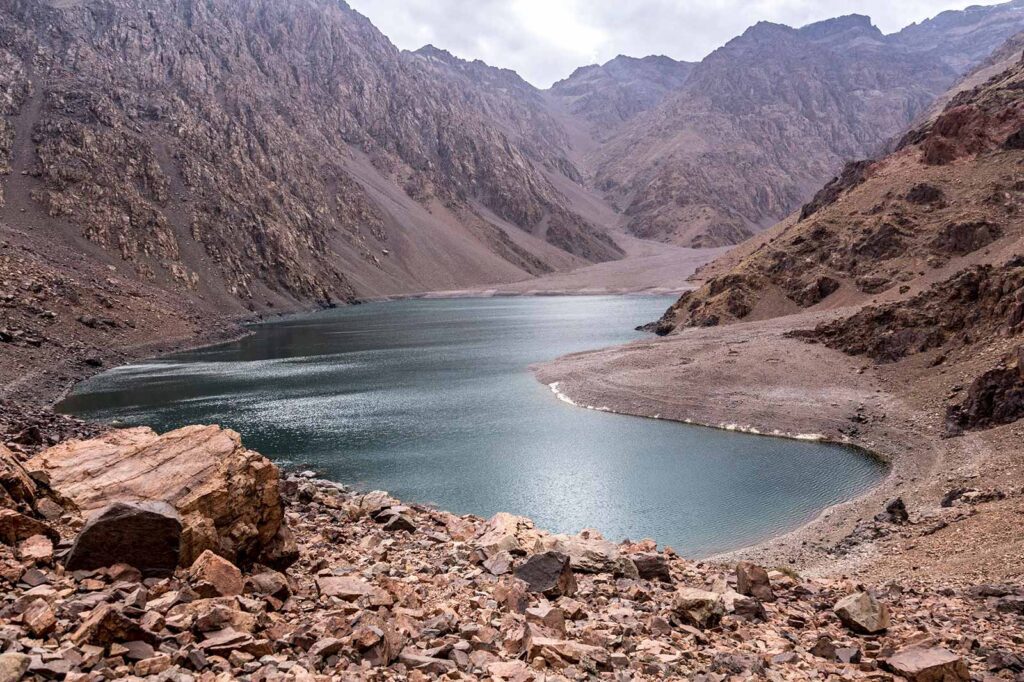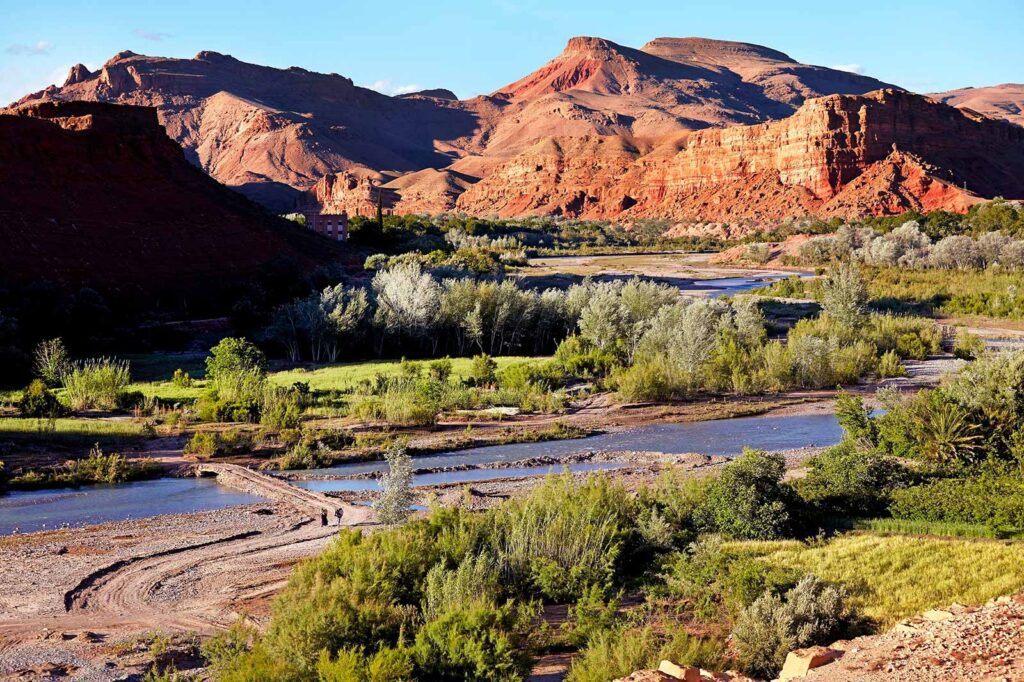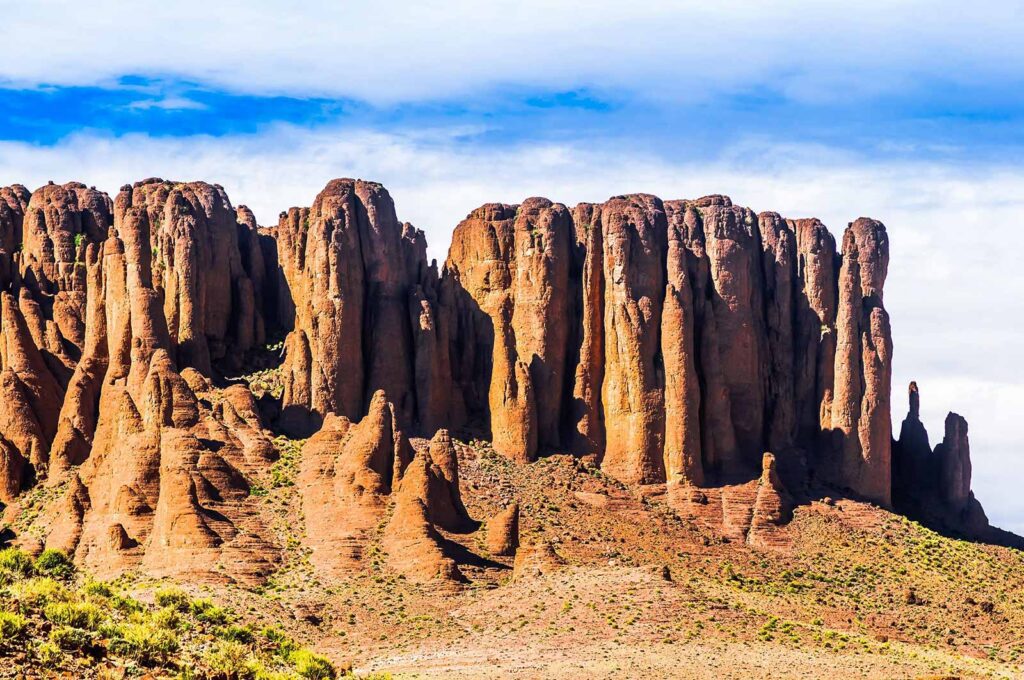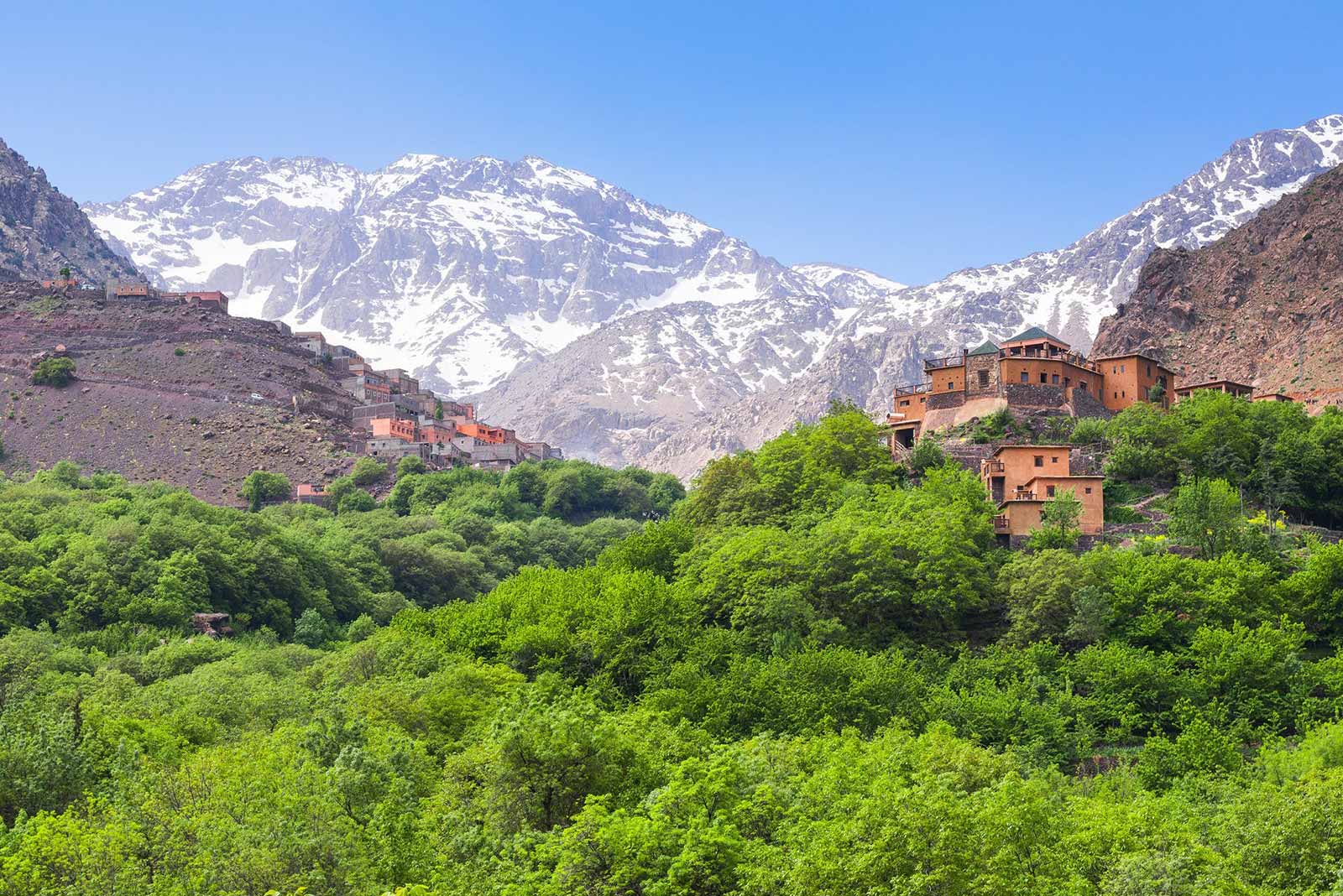Being the highest peak in North Africa, the summit of Toubkal at 4167m has emerged as the top tourist attraction in Morocco’s High Atlas Mountains. However, beyond the popular Toubkal ascent lies a collection of unparalleled hiking trails that remain largely undiscovered by tourists. While crowds leisurely make their way up the two-day trek to Toubkal, an abundance of extraordinary routes meandering through rugged ridges awaits adventurous souls.
These trails trace the footsteps of shepherds through ancient paths connecting remote villages, offering you an opportunity to engage with the Amazigh (Berber) villagers and immerse yourself in their unique culture, hospitality, architecture, and language. Along the way, you’ll traverse mountain pastures, skirt beneath craggy massifs, and cross panoramic passes. These trails provide a culturally immersive experience and a variety of landscapes that surpass a direct summit ascent.
Toubkal Circuit:

Embarking from the same trailhead as the Toubkal ascent, the Toubkal Circuit diverges from the direct summit path, taking you on a challenging seven-day journey around the Toubkal Massif. This circuit explores the traditional lifestyles of the region, offering a deeper understanding of the local culture. While a local guide is mandatory for all Toubkal ascents, they also provide invaluable cultural insights, making your interactions along the trail even more rewarding. Trekking past the homes of seasonal herders in the summer pastures of Azib Likemt, you may find yourself invited for tea by these locals, who have practiced an agricultural and pastoral lifestyle in the valley for centuries.
Descending into the village of Amsouzart, passing through prosperous walnut orchards and the remains of pisé (rammed earth) houses abandoned in favor of modern constructions, you’ll be greeted warmly by the curiosity of village children and friendly shopkeepers. If luck favors you, one of the shopkeepers might even offer you a taste of the valley’s exquisite local honey. Continuing beyond Amsouzert, you’ll encounter the diminutive yet popular Ifni Lake, where Marrakechis often escape the scorching summers. For hikers, it serves as a delightful spot for lunch or a refreshing glass of freshly squeezed orange juice before ascending toward a campsite just below the Tizi n’Ouanoums pass.
Although not without challenges and a touch of treachery (which makes the presence of a guide highly appreciated), a small side path leads to a back-side ascent of the Toubkal Pass (4000m), connecting to the final leg toward the summit. While it’s possible to complete the trek back to Imlil on the same day, hikers with energy to spare often venture over the Tizi n’Aguelzim pass to witness the impressive Cascades d’Irhoulidene and reach another small pasturage at Azib Tamsoult before looping back to the trailhead.
M’Goun Traverse:

The three-day M’Goun Traverse encompasses trails that wind through flowing streams and rocky ravines, offering overnight stays in remote villages adorned with towering kasbahs (fortresses). However, the highlight of this route is the commanding presence of Jbel M’Goun at 4071m. The rugged landscapes and the region’s resistance to central authority have resulted in cultural and geographical disconnection from areas closer to Marrakesh. The trailhead village of Agouti in Aït Bougoumez only became accessible by road in 2016.
Fortunately, numerous old shepherds’ trails that cross the mountains still exist, including a captivating hike above Aït Bougoumez and several small passes leading to the picturesque Tifra Valley village of Rougoult. Rougoult is renowned as one of the most stunning villages in the M’Goun region, with traditional-style houses clinging to the hillsides, overlooking verdant small fields on either side of the Tifra River. As night falls, hikers have the option to stay in one of the inviting informal guesthouses or fall asleep on a rooftop, gazing at the dark silhouette of the towering peaks while the village lights twinkle below.

Ascending the 2900m Tizi n’Rougoult, a three-hour hike up the Tifra River (or, in springtime, sometimes through it), unveils breathtaking vistas that stretch beyond the horizon, encompassing ochre rock walls and tempting trails leading to Jbel M’Goun and beyond. The path descends to the prosperous village of Amezri, nestled alongside the Tassaout River. Amezri, the largest village in the region, owes its growth in part to a new mountain road connecting it to the market at Skoura. Aimless wandering through its relatively sprawling streets rewards visitors with warm greetings from the locals.
The final leg of the trek through the Tassaout Valley presents hikers with two options. The straightforward choice is a road walk through charming villages, including the remarkable cliffside village of Ichbaken. Alternatively, a higher-altitude trail weaves through shepherds’ pastures and picturesque passes, culminating in Aït Alli n’Ito, home to one of the finest guesthouses in the region, Gîte d’Étape Assanfou. From there, hikers can embark on day hikes to nearby traditional villages such as Magdaz and Fakhour.
Jbel Saghro:

The Saghro Massif offers a distinct contrast to the more popular hiking destinations in Morocco. Harsh desert landscapes and palm-fringed oases replace the lush valleys and scattered villages found at higher elevations. Nevertheless, the Saghro Massif unveils picturesque views and a warmth of hospitality that rivals any other region.
Hiking days in Saghro tend to be longer, both in terms of distance and duration, compared to other parts of the country. The trails culminate at the 2712m Amalou n’Mansour, resulting in shorter climbs and gentler slopes. Combined with leisurely lunches to escape the midday heat, a Saghro hike offers a laid-back alternative to the more popular Atlas regions.
Saghro presents an array of low-lying, hikeable passes, offering numerous options for loop hikes or one-way walks between trailhead villages. Most hikers design their routes around cultural and natural highlights. Notably, the village of Assaka n’Aït Ouzzine stands out, featuring a centuries-old agadir (traditional granary) that gracefully crumbles within a postcard oasis, surrounded by palm trees lining a small stream accessible via footpaths.
At the intersection of three valleys, dirt roads lead west over the Tagmout pass, revealing twisting rocky canyons, or east over the Tagourt pass, where dramatic landscapes with evocative names like ‘Camel’s Head Hill’ and the ‘Needles of Saghro’ await. Above the Ouarg Valley, Jebel Kouaouch (2595m) offers panoramic views that rival those of Toubkal, stretching from the M’Goun Massif in the north to the Sahara dunes in the south. This remarkable vista encompasses countless valleys, villages, and hikes waiting to be explored.
Embark on an unforgettable adventure through Morocco’s High Atlas Mountains and discover the hidden treasures of these remarkable hiking trails. Beyond the crowded paths to Toubkal, you’ll find a world of cultural immersion, breathtaking landscapes, and encounters with the welcoming local communities.
Whether you choose the Toubkal Circuit, where you’ll circumnavigate the Toubkal Massif over a seven-day adventure, or embark on the M’Goun Traverse, delving into remote villages and traversing rocky ravines for three memorable days, each route offers a unique experience. The Toubkal Circuit allows you to delve deeper into the traditional lifestyles of the region, while the M’Goun Traverse unveils the dominance of Jbel M’Goun and introduces you to the picturesque villages of Aït Bougoumez.
For those seeking a different side of Morocco’s hiking trails, the Jbel Saghro presents a captivating alternative. Explore harsh desert landscapes, lush palm-fringed oases, and awe-inspiring views from Amalou n’Mansour. The Saghro Massif’s distinct charm lies in its laid-back atmosphere, longer hiking days, and an array of low-lying passes that invite you to create your own adventure.
Immerse yourself in the rich history, hospitality, and breathtaking scenery that Morocco’s High Atlas Mountains have to offer. From the remote villages along ancient shepherds’ trails to the rugged peaks and stunning vistas, these trails will leave you with unforgettable memories.
So, lace up your hiking boots, embrace the spirit of adventure, and embark on a journey through Morocco’s High Atlas Mountains, where the best hikes await those who dare to explore beyond the beaten path.


